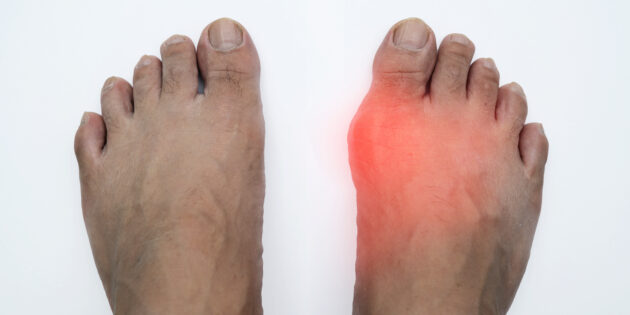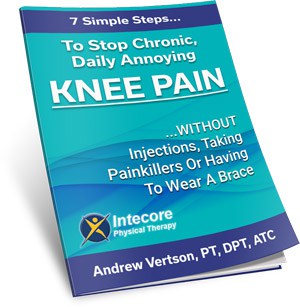
Gout is one of the most painful joint conditions you can experience.
The pain can come on suddenly (often in the middle of the night) and feel sharp, hot, and almost unbearable.
If you’re dealing with recurring joint pain or wondering what gout actually is, this article is for you. Gout affects millions of people worldwide, and flare-ups can stop you in your tracks.
The good news: gout is treatable! And understanding what causes it is the first step toward preventing future attacks.
Table of Contents
What Is Gout?
Gout is a type of inflammatory arthritis caused by too much uric acid in the blood.
When uric acid levels get too high, sharp crystals form inside a joint, most commonly the big toe, and trigger sudden swelling, redness, and intense pain.
Uric acid is a natural waste product your body makes when it breaks down purines, which are substances found in your own tissues and in certain foods.
When your kidneys can’t remove enough uric acid, it builds up. That buildup becomes needle-like crystals, and that’s what causes the extreme pain.
What Are the Symptoms of Gout?
A gout attack usually starts suddenly. Most of our patients describe it as:
- Intense joint pain, often in the big toe
- Redness, warmth, and swelling
- Pain that is worse at night
- Tenderness even from light pressure, like a bedsheet touching the toe
In some cases, gout can also affect the ankle, knee, foot, wrist, or fingers.
Even after the severe pain fades, the joint can feel stiff or sore for days.
What Causes Gout?
Gout develops when there’s too much uric acid in your bloodstream, and your body can’t get rid of it fast enough. Uric acid isn’t a bad thing on its own — your body naturally makes it when it breaks down purines (substances found in your tissues and in certain foods). But when levels rise too high, uric acid forms sharp, needle-like crystals in the joints. That’s what causes the intense swelling, heat, and pain during a gout attack.
Here’s a closer look at the most common reasons uric acid builds up:
1. A Diet High in Purines
Some foods naturally contain higher amounts of purines. When your body breaks them down, uric acid levels rise. If your system can’t process that extra uric acid, it settles into a joint and triggers a flare.
Common high-purine foods include:
- Red meat (beef, pork, lamb)
- Organ meats (liver, kidneys)
- Shellfish (shrimp, lobster, crab)
- Anchovies and sardines
- Alcohol — especially beer, which is a major trigger for many people
These foods don’t cause gout on their own, but if your body already struggles with uric acid, they can push you past your threshold.
2. Dehydration
Water helps your kidneys filter out uric acid. When you’re dehydrated — even mildly — that filtration system slows down.
Less water in your system means more uric acid stays in your bloodstream, increasing the chances of crystal formation.
It’s one of the simplest things people overlook, but staying hydrated is a major part of gout prevention.
3. Weight, Metabolic Issues, or Blood Pressure Problems
Your body’s metabolism plays a big role in how efficiently you produce and eliminate uric acid. Conditions like:
- Obesity
- High blood pressure
- Insulin resistance or prediabetes
- Kidney problems
can all make it harder for your body to maintain healthy uric acid levels.
The kidneys are especially important — they’re responsible for removing two-thirds of your uric acid every day. If they’re not working at full capacity, uric acid builds up quickly.
4. Genetics
Some people are simply born with a higher tendency to accumulate uric acid. If close family members have gout, your risk is significantly higher, even if your diet is healthy and you stay active.
Researchers estimate that up to 20% of gout cases have a genetic component. Your body may produce more uric acid, hold onto more of it, or have kidneys that don’t clear it efficiently.
5. Certain Medications
Some medications make it harder for the kidneys to eliminate uric acid. The most common ones include:
- Diuretics (“water pills”)
- Certain blood-pressure medications
- Aspirin (when taken daily in low doses)
- Drugs used after organ transplantation
These medications are necessary for many people, but they can raise gout risk. If you’re taking any of these and experiencing flare-ups, it’s worth having a conversation with your doctor — often, adjustments can be made without compromising your health.
Bottom Line
Gout is rarely caused by one single thing. It’s usually a combination of genetics, lifestyle factors, kidney function, and diet. Understanding what raises uric acid — and what your personal triggers are — is the best way to stay ahead of gout attacks and protect your joints long-term.
How Is Gout Diagnosed?
A healthcare provider may:
- Review your symptoms
- Examine the affected joint
- Run blood tests for uric acid levels
- Draw joint fluid to confirm the presence of uric acid crystals (the gold standard)
How Is Gout Treated?
Gout treatment usually has two parts: treating the flare and preventing the next one.
During a flare
- Anti-inflammatory medication (NSAIDs or colchicine)
- Resting and elevating the joint
- Applying ice
Long-term management
- Medications that lower uric acid levels (if needed)
- Dietary changes
- Weight management
- Drinking plenty of water
- Managing blood pressure, kidney health, or metabolic conditions
Small daily changes often lead to fewer and less severe gout attacks.
Can Physical Therapy Help With Gout?
Absolutely! And for many people, it makes a bigger difference than they expect.
Most people think of gout as something that only needs medication, but once the inflammation settles, you may be left with stiffness, weakness, and limited movement in the affected joint. That’s where physical therapy becomes a key part of long-term recovery.
During a gout flare, your body naturally protects the joint by making you avoid movement. This is normal — but after the flare ends, those muscles and tissues around the joint can remain tight or sensitive. If this keeps happening flare after flare, the joint can gradually lose mobility and strength.
Physical therapy helps you break that cycle.
How Physical Therapy Helps After a Gout Flare
Restoring joint mobility
When a joint swells repeatedly (especially the big toe, ankle, or knee), the tissues around it tighten. PT uses gentle stretching, manual therapy, and targeted movement to help the joint glide and bend normally again. This reduces stiffness and improves the way you walk.
Reducing inflammation with guided movement
It may sound strange, but the right kind of movement can actually help the body clear lingering inflammation. A physical therapist teaches you safe mobility exercises that improve circulation and calm the area — without aggravating symptoms.
Strengthening the muscles around the joint
When a joint hurts, the surrounding muscles weaken quickly. That weakness puts more pressure on the joint and increases the likelihood of another flare-up. Strengthening those muscles improves stability and makes everyday activities (walking, climbing stairs, standing) feel easier.
Helping you walk and move more comfortably
Many people unknowingly change the way they walk after a gout flare — limping, avoiding pressure, or shifting their weight to the other leg. Over time, this can create new problems in the knees, hips, or low back. PT helps you regain a natural walking pattern so you don’t develop secondary pain.
(If you need help with Gout, we’re here for you, please get in touch here.)
Education on what’s safe (and what’s not)
Not every type of exercise or shoe choice is helpful during recovery from gout. We can guide you on:
- how to move safely during a flare
- when to progress activity
- which stretches help most
- which movements to avoid
- what footwear supports the inflamed joint
- how to prevent joint irritation during daily tasks
Simple changes — like adjusting your walking pattern or modifying your daily routine — can significantly reduce discomfort.
Why This Matters Long-Term
Every time you have a gout flare, the inflammation puts stress on the joint surfaces. Over years, repeated flares can lead to chronic stiffness, reduced mobility, and even early joint degeneration. Many patients don’t realize this until their joint already feels permanently “tight” or “weak.”
Physical therapy helps prevent those long-term issues by keeping the joint moving well, strong, and stable — so each flare causes less damage and recovery becomes smoother.
If gout keeps getting in the way of how you walk, move, or live your day-to-day life, PT can help you stay active and protect your joints for years to come.
FAQ
What foods trigger gout?
Foods high in purines tend to raise uric acid levels and trigger gout attacks. The most common culprits include red meat, organ meats (liver, kidney), shellfish, anchovies, sardines, beer, and sugary drinks made with high-fructose corn syrup. These foods cause your body to produce more uric acid than your kidneys can clear.
What are the main causes of gout?
The main cause of gout is too much uric acid in the blood (hyperuricemia).
This can happen for several reasons:
– Your body produces too much uric acid
– Your kidneys don’t remove uric acid efficiently
– You eat high-purine foods often
– You’re dehydrated
– You have metabolic issues like high blood pressure, insulin resistance, or excess weight
– Genetics, kidney problems, and certain medications (like diuretics) can also increase your risk.
What is the quickest way to get ride of gout?
The quickest way to relieve a gout flare is a combination of:
Anti-inflammatory medication, such as NSAIDs or colchicine
Resting the joint and elevating it
Applying ice for 20 minutes at a time
Staying hydrated to help flush out uric acid
If flares keep coming back, long-term uric-acid-lowering medication may be needed.
What does gout look like on your foot?
On the foot — especially the big toe joint — gout usually appears as:
– Sudden, severe swelling
– A tight, shiny, red or purple-colored joint
– Skin that feels warm or hot
– Extreme tenderness, sometimes so painful that even a bedsheet feels unbearable
– As gout progresses over time, firm bumps called tophi may form around the toe or foot if uric acid crystals accumulate under the skin.
Get Help For Gout with Physical Therapy
If joint pain or recurring gout attacks are affecting your quality of life, our team can help you move comfortably again and prevent long-term joint issues.
👉 Click here to schedule an appointment, or call 949-597-2103.
Let’s help you get back to living without the pain and worry of another gout flare.
- What Is Gout? Why It Happens and What You Can Do About It - November 17, 2025
- 3 Essential Back-Saving Tips You MUST Know Before Any Workout - November 14, 2025
- Are You Experiencing Shoulder Pain from Sleeping Wrong? - October 21, 2025













